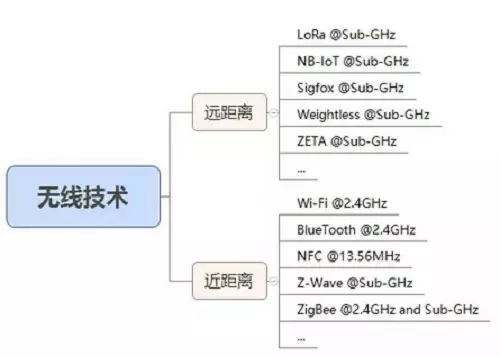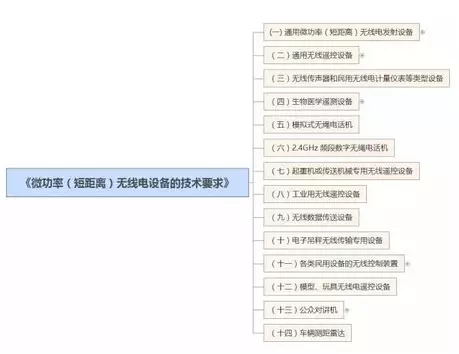Wireless communication technology requires a certain frequency band to communicate, just as a car needs to drive on the road. In the application of IoT, the frequency of wireless technology used in different countries or regions is also different.
In order to adapt to the development of the Internet of Things, countries or regions provide certain frequency bands for IoT applications. The frequencies are divided as follows:
North America : 902-928MHz
European Union: 863-868MHz
South Korea : 917.5-923 MHz
Japan : 916.5-927.5MHz
United Kingdom: 915-921 MHz
What are the frequency bands applicable to China's Internet of Things market? Especially for those emerging low-power wide area networks (LPWAN) in China, which frequency bands are suitable?
Frequency of wireless technology
If wireless technologies are classified according to the transmission distance, some common IoT wireless technologies can be classified as follows:

LoRa, China's LoRa Applications Alliance (CLAA) recommends 470~510MHz.
NB-IoT, the global mainstream frequency band is 800MHz and 900MHz. China Telecom will use 800MHz as the preferred frequency band for deploying NB-IoT. China Unicom will choose 900MHz to deploy NB-IoT, and China Mobile may renew its existing 900MHz frequency band.
Sigfox, Europe, Middle East: 868 MHz (ETSI 300-220), North America: 902 MHz (FCC part 15), South America/Australia/New Zealand: 920 MHz (ANATEL 506, AS/NZS 4268).
Weightless, as an open standard LPWAN wireless technology, works throughout the license-free Sub-GHz ISM/SRD band and can be deployed worldwide: 169/433/470/780/868/915/923 MHz.
ZETA, a technology developed in tandem, can operate in multiple Sub-GHz frequency bands (eg, 433, 470, 500, 787, 868, and 915 MHz, etc.). In addition, ZETA can also operate on proprietary frequency bands by changing the configuration.
Wi-Fi and Bluetooth, work in 2.4GHz, universal frequency band.
NFC, it is learned that the Ministry of Industry and Information Technology will release a near-field communication technology standard based on 13.56MHz.
Z-Wave, which operates in China at 868.40 MHz, complies with the CNAS/EN 300 220 standard.
Specifications such as ZigBee, Thread, and ISA100.11a are all based on the IEEE 802.15.4 standard. General IEEE 802.15.4 devices use 868/915/2400 MHz frequencies.
In addition to 2.4 GHz, etc., IoT wireless technology mostly uses Sub-GHz band. What regulations and requirements does China have for the existing wireless spectrum?
Radio frequency regulations and requirements
There are the following rules, requirements, and standards for IoT related:
"PRC Radio Frequency Division Regulations"
Technical Requirements for Micropower (Short Range) Radio Equipment
IEEE Std 802.15.4c? -2009
"Notice on Increasing Operating Frequency of Micropower (Short Range) Radio Applications at 800MHz Band"
Technical Requirements for Micropower (Short Range) Radio Equipment
In 2005, the Ministry of Industry and Information Technology revisited and issued the "Technical Requirements for Micropower (Short Range) Radio Equipment." The Ministry of Information does not have document [2005]423. "Requirements" classifies 14 types of equipment: 
Among them, (iii) Types of equipment such as wireless microphones and civil radio meters
Audiovisual training for education and cultural departments, auditory aids for use in public places such as movie theaters, concert halls, conference rooms, and people with disabilities, as a small-scale broadcasting equipment application in tourist areas.
When the transmission data is satisfied and the transmitter operating time does not exceed 5 seconds, the 470-510 MHz band can be used as a frequency band for civil radio meters.
If the frequency of use is the same as the frequency of local sound and television broadcasting stations, they must not be used locally; if there is any interference with the local sound or TV broadcast reception, they should be immediately stopped and can be reused until the interference is eliminated or the interference-free frequency is adjusted.
To avoid interference with biomedical telemetry equipment, wireless microphones must not be used in hospitals. Wireless microphone manufacturers must specify this requirement in the product specification.
1. Use frequency and transmit power :
1) Use frequency : 87-108 MHz
Transmission power limit : 3mW(erp)
2) Use frequency : 75.4-76.0MHz, 84-87MHz
Transmitting power limit: 10mW(erp)
3) Use frequency : 189.9-223.0MHz
Transmitting power limit : 10mW(erp)
4) Use frequency: 470-510MHz, 630-787MHz
Transmitting power limit: 50mW(erp)
2. Occupied bandwidth: no more than 200kHz
3. Frequency tolerance: 100×10-6
(11) Wireless control devices for various types of civilian equipment
Must not be used for wireless control of toys, models, etc.
1. Use frequency : 314-316MHz, 430-432MHz, 433.00-434.79MHz
Transmitting power limit : 10mW(erp)
Occupied bandwidth : no more than 400 kHz
2. Use frequency: 779-787MHz,
Transmitting power limit : 10mW(erp)
IEEE Std 802.15.4c? -2009
According to the description of Baidu Encyclopedia, IEEE802.15.4C was co-promoted and promoted by China Electronics Technology Standardization Institute, Beijing Aerospace University, Tsinghua Tongfang, Huawei Technologies Co., Ltd. and Beijing Weixun Amethyst Technology Co., Ltd., IEEE 802.15.4C The standard was officially released on March 29th.

F.3.2 Radio control devices for all kinds of civil equipment
Radio controlled devices are prohibited for use for toys and models, but can be used for civilian equipment for the following working frequencies:
a) Working frequency: 314-316 MHz, 430-432 MHz, and 433.00-434.79 MHz
Transmitting power limit: 10 mW (EIRP)
Occupied bandwidth: no greater than 400 kHz
b) Working frequency: 779–787 MHz
Transmitting power limit: 10 mW (EIRP)
No occupy bandwidth requirement
Notice on Increasing the Operating Frequency of Micropower (Short Range) Radio Applications in the 800MHz Frequency Band Letter No. [2008] No. 44
In order to promote the development of micro-power (short-range) radio technologies and meet the needs of the society, according to the frequency division and usage of our country, we have increased the operating frequency of 868-868.6 MHz for micro-power (short-range) radio applications. The details of the notice are as follows:
First, the radio frequency requirements of the micro-power (short-range) radio equipment in this band:
1. Launch power limit : 5mW(erp);
2. The duty cycle limit of the transmitted signal: 1%;
3. Carrier frequency tolerance: 100×10-6.
Second, radio equipment of this frequency band is classified as "radio control device for various types of civil equipment" in the "Notice No. [2005] No. 423" for the issuance of "Technical Requirements for Micropower (Short Range) Radio Equipment". .
Kenwood Radio,Kenwood Walkie Talkie,Kenwood Double Din Radio,Kenwood Handheld Radio
Guangzhou Etmy Technology Co., Ltd. , https://www.digitaltalkie.com